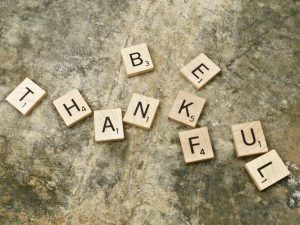Posts by Annie Neugebauer
This is my last post for Writer Unboxed as a regular contributor. As I write this, I feel sad, nostalgic, and grateful, grateful, grateful.
Aside from a single guest post in 2011, I began at WU in 2013 with an every-other-month column about Twitter. Three years later, we opened my topics to The World Beyond Twitter to save my sanity, and I spent two years posting about all kinds of things, from query letters to facing fears and more.
My plate just kept getting more and more full, though, and even every other month began to feel like too much. Sweet Mama T offered for me to post less frequently rather than leaving altogether, so I stepped it down to four posts a year, and then three posts a year, and now I’m at two posts a year and somehow I’ve still managed to miss one of them. (The pandemic and a toddler ate my homework.)
After seven and half years (!!!) of writing for this beautiful community, it’s painfully clear to me that I can’t keep WU on my writer’s plate at this point in my life. In the past few years I’ve had to cut back lots of not-fiction-writing writing tasks. I stepped down from leading my local critique group. I stopped webmastering for the Poetry Society of Texas. I’ve let dues expire, said no like it’s my job, and I haven’t updated my own author blog since April. Now I’ve dragged myself kicking and screaming to the acknowledgement that WU, too, is beyond my capacity at this point in my life. Even just twice a year.
This is not a farewell post, though. (At least not only.) This has prompted me to think about a larger topic that, I think, all writers might face if we write for any length of time: the ebb and flow.
How on earth do we accept the larger pattern of things when we can’t see it yet? And I’m not talking about fate or destiny here—though I imagine believing in those things might make it a bit easier—but rather the simple fact that every life has a shape in the end. Very few single days or single decisions change the whole shape, but rather build it up over time.
Take my AIS mantra, for example. (Butt in chair is a slightly nicer way of saying it.) You show up at the keyboard every day that you’re supposed to. That simple. You just do it.
Until you get sick, or your cat gets sick, or your depression overtakes you, or you get a different job to cover the bills, or your yard floods, or your air conditioning breaks, or your computer decides to start automatic updates on the day your column is due, or a dictator overthrows your country, or or or…
Life changes. Many of us, myself included, fight that, but it is the nature of existence. Nothing ever stays the same, so fighting it is futile. How, though, can we even begin to accept that with a modicum of grace?
I certainly don’t have the answer(s) all figured out, but there is one thing that has helped me many times:
Read MoreI’ve shared tons of writing advice over the years, both in craft and lifestyle, and it’s always been a pleasure to pass along the things I’ve learned from others (or figured out the hard way). But I’ve done only one list of cohesive advice before, called “My Advice to My Newbie Writer Self: 20 Things I Wish I’d Known 7 Years Ago,” and now somehow that post itself is five years old? (Shh.)
I guess that’s why I feel the call to share again a list of things I’ve learned along the way—five years is a lot of experience to mine. So what do I mean by writers who are “in it,” and what do I mean by “advice”?
By “in it,” I mean deeply submerged in the journey of publication—not just starting out. (There is, of course, nothing wrong with being new to the game; that’s just not who I’m really talking to this time.) For you, that might look like ten years querying and still not finding an agent. It might mean you’re on your fifth book deal. Or it might mean you’ve chosen to self-publish, get into academia, or what have you. I’m really just referring to a level of commitment and longevity that means you’re no spring chicken when it comes to this crazy field we work in.
And by “advice,” I mean advice to myself, reminders to others, suggestions for anyone who ends up finding them helpful. I truly believe that no advice is universal, and I certainly don’t have any claim on being right or having figured everything out. These are just the realizations and philosophies that I’ve found most useful over the years. Please take them as you will. ♥ Let’s go!
Work Harder
No, not more. Not longer. Not faster. Harder. No one is tallying your total hours spent (probably), nor do you get any points for being a fast typist or a workaholic. What matters is that you do your best work as often as you can without burning out. When you’re mid-project, you need to be deep, deep in your high-effort zone every work day for a good chunk of time. It’s not about what other people are doing or can do; it’s about what you can do. Work hard, and you’ll feel good about it.
Submit More
Yes, more. You should be embarrassed by how many rejections you get. They should outnumber your acceptances at least 10 to 1. Even if you’re deep in the game and have a name for yourself and get solicited to send in work. There are always more markets, and you can break them. (Or you can try, because how will you know if they’ll say yes if you don’t send something in?) So submit more, and don’t quit until everything you’re proud of has been placed somewhere. And then write more stuff.
Exploit Your Strengths
You’re probably really good at certain things, right? You might even be “known for” something—even if it’s just among your writing partners and peers. I can’t tell you how many writers I’ve heard express a fear that they’re overusing that very strength they’re best at. […]
Read More“Blue mountains” by Adam Kubalica
I talk about fear and bravery a lot because they’re big parts of my writing life—and not just because I write horror. I encourage writers (including myself) to be brave and take risks. Ideally the groundwork of education, hard work, and patience is already laid so they’re smart risks. But once it is, we can’t get anywhere truly special without facing down fear and going for it. I believe that down to my bones.
And yet, sometimes risks don’t pay off. Sometimes we face fear only to fail. Sometimes boldness and bravery still aren’t enough.
What do we do when risks go wrong?
This is something I’ve struggled with quite often, I’m afraid. Part of being a big dreamer and a big risk-taker is failing a lot. There are all kinds of trite sayings about how failing just proves you tried, that it’s one step closer to succeeding, etc., but those things aren’t very comforting to me when I’m in that heartache phase. Not much is, to be honest.
That’s why I’m a big believer in giving myself time to grieve. When a risk goes wrong, I let myself take time to mourn the loss. Depending on exactly how big that risk was, that might mean taking a few moments with tears stinging my eyes or it might mean a week of changing course or it might even mean months of licking my wounds. I don’t mean that I throw an epic pity party or wallow in it just for the sake of wallowing; I just mean that I respect my emotions. They’re an unavoidable human reaction. Why pretend we can stop them?
Of course that also entails understanding when to move on. Some hurts can be kept fresh for far longer than they need to be, and that doesn’t benefit anyone. I wish there was a formula or some easy wisdom on this one, but if there is, I haven’t found it yet. All I know is that at some point, we need to move forward.
Often, moving forward means making new plans and/or setting new goals and accepting that these, too, come with inherent risk. If they’re worth anything, they have to. No risk, no gain, right? But how do we let ourselves risk again when we know how badly it can hurt when it goes wrong?
Read MoreOne of the hardest lessons I’ve had to learn—and am still constantly learning—as a writer has been patience. Not just moment-to-moment, don’t-re-check-your-inbox patience, but long term, forest-for-the-trees patience. I have had to learn my craft, learn the industry, and then learn to readjust my expectations accordingly. I have had to learn as much as I can about all the things I can (_o/) so I have the confidence to admit that the rest is out of my hands. I have had to learn to show myself grace, to release the fatalism that comes with failure, and to know when to step back and take the broad view.
I’d like to say I learned all that smoothly and quickly, but it’s been a struggle every step of the way.
One of the beautiful things that comes with having over a decade in the thick of it behind you is that you begin to see the broader picture more easily. I remember when I first started out how I felt drafting my first novel. I was certain that I had to do it as quickly as possible. I’m not sure why. Generalized impatience, I guess. I’d decided what I wanted to do and so I wanted to get it done. I wanted to write it fast, edit it fast, sell it fast. I wanted to be twenty years in during year one. Obviously, that’s not how it works. Perhaps luckily, I didn’t realize that at the time, and so I started at the beginning, which is the only way to do it.
With almost every project I’ve ever worked on, I feel a sense of urgency. Some of that is creative drive, which is a glorious, magical thing that I cherish and don’t mess with. But some of it is impatience. I want the next thing. I wanted something published. I wanted an agent. I wanted a book deal. I want, I want, I want, and wanting makes us (or at least me) hurry.
Hurrying isn’t the same thing as working hard. That’s another lesson I’ve learned the hard way. You can do both sometimes, but usually you have to choose working hard as your priority or hurrying takes over. Getting it finished becomes more important than getting it right. When we think about it that way, it becomes obvious that we need to take our time and do the work. But in the thick of things, it can feel almost impossible to slow down and resist the temptation to cross things off our list by taking shortcuts.
How do we step back far enough to see the forest for the trees when we’re already deep inside the forest?
Read MoreIn my last post I talked about “which types of readers to use for feedback,” covering the pros and cons of a weekly critique group, beta readers, specialty readers, and agents and editors. Knowing where to get feedback on our work is great, but what the heck do you do with it once you have it? It might sound like a straightforward question, but any writer gathering significant feedback knows how daunting it can be to face sorting through and implementing that critique.
The good news is that there is no one correct way to go through this process. The bad news is that there is no one correct way to go through this process. Every writer, every book, and every feedback resource will require different specifics. That freedom is liberating and, sometimes, a little overwhelming. In hopes of establishing a starting place, today I’m going to share my general outline of the steps I take to process and filter reader feedback. As with all writing advice, take what works for you and leave the rest.
1. Read Feedback
Step one is fairly easy straightforward: consume the feedback. If you’re reading notes, I highly recommend finding a private, quiet place so you can go at your own pace and so you don’t have to school your reactions. If you’re listening, and if your reader doesn’t have notes to hand you after they’re done talking, go ahead and take notes as they go (unless you can record or have a killer memory). Try to resist asking too many questions, especially if you’re new. Clarifying what someone means is fine, but you’d be surprised how easily that slips into justifying or defending our intentions instead. You can sort through that part later; for now, just listen and absorb.
2. Let Yourself Feel, Notice Your Gut
You might feel things as you listen. Some of them might even be bad feelings. That’s okay. Emotions are not only important, but biologically required. So don’t beat yourself up if you feel sad, disappointed, angry, scared, overwhelmed, etc. That’s all normal. (It’s also why I generally prefer to read feedback in private.)
Of course, if you’re in person you’ll probably be socially obligated to hide or subdue some of these feelings to seem “sane” and “professional.” (Bah.) Do what you must, but even if you have to bottle it up, I highly recommend letting it out later. Let it aaaaaaall out. Let it have free reign for a while—good and bad. Be excited, be intimidated, be whatever you need to be.
And more importantly, pay attention to what you need to be. To take every drop of romance out of it: emotional reactions are data. How we feel right away upon each particular piece of feedback is invaluable information for later, so stop trying to stymie it. Instead, let it happen and take a mental note. Pay extra attention to the things that make you the most defensive.
3. Organize
Read MoreEvery writer needs feedback before publication—every writer and every book. It’s a critical part of the process. In fact, it’s several critical parts of the process, because a savvy writer will come to learn that it’s usually most effective to get different types of feedback at different stages. The types of problems a weekly critique group will catch are not the same types of issues a trusted beta reader will point out.
Finding these different types of readers to give you feedback can be a difficult process in itself. It’s taken me years to find the people whose styles I click with and build a circle of solid working relationships I can count on. There’s a little bit of luck involved, and a whole lot of persistence. If you’re still searching for your people, don’t give up. Keep reaching out, whether in person or online, until you find them. They’re well worth your effort.
Today I’m going to share some of the ‘types’ of readers I use, what their different values are, and when I utilize which read-throughs. Not every writer will need every one of these, mind you, but it should give a good frame of reference for filling out your own (probably ever-changing) circle.
A Weekly Critique Group
This is where I started. I still go to my in-person critique group almost every week. I could do an entire post just about critique groups, but I’ll cut to the chase. A weekly critique group alone is not enough. There are things that no critique group, no matter how good, will ever be able to offer you. But there are other things that only they offer—almost exclusively.
Reading a longer work like a novel split into week-by-weekly digestible chunks does interesting things to perspective. A crit group won’t reliably offer you macro critique, but they will almost always zoom in and offer much more detailed micro critique. Does this scene work within the larger scope of the book? They might not have a sense for that. But does the scene work on its own? They can tell you much more honestly than a beta reader, who’s naturally tempted to view scenes within the larger context. Reading only one scene or chapter at a time and being forced to stop and discuss it before moving on is not the natural pace of reading; it forces more attention to detail and encourages more frequent reflection.
Another good thing about receiving feedback one week at a time is spotting patterns. Most critique groups have a varying membership, often even week to week, so you get a broader range of readers. Though this is occasionally frustrating (when someone doesn’t understand something they missed from a previous week), it can also be enlightening. What feedback do you tend to hear most often? Do different groups tell you the same things about different sections? If so, you can start to home in on your general weaknesses in craft. That’s invaluable data.
Even a trusted critique partner you send material to week by week can’t show you larger trends the way a critique group can. If you have access to an in-person crit group, I highly recommend giving it a fair […]
Read MoreMy husband who climbs mountains (I know) once told me about a phenomenon one of his peers had experienced, known in the field as “summit fever.” Poet me perked immediately, drawn to the ping of that phrase. Then he told me what it means, and writer me just about had to scoop my jaw off the table.
When a climber or group of climbers plans an ascent, they also have to plan the descent, which includes a timeline for everything. They look at weather and conditions that might make the climb slower than expected or otherwise hinder their plan, and, importantly, they decide up front on a turn-back time. Climbing is dangerous, especially at night or under adverse conditions, and there’s only so much water and food you can take with you; you’ll need half left for climbing back down.
For example, let’s say it’s a one-day climb; they need to be back to base camp before dark. If they start at dawn, they’ll need to be heading back six hours in at the very latest. That’s the agreed upon turn-back time, even if for some reason they haven’t reached the summit yet.
It happens all the time: plans go awry. The ground is wetter than they thought, making the layer right beneath the surface slick and muddy, prone to slipping once their weight is on it. They’re in good shape, but the air is thinner than they accounted for, leaving them winded too easily and requiring more short breaks to catch their breath. And even though the forecast said clear skies, some nasty-looking clouds have rolled in, casting everything in twilight even though it’s not dusk yet.
Still, they soldier on, pushing through fatigue and slippery terrain, and they make good progress—just not quite good enough. Five and a half hours in, they stop to assess; they’d hoped to be at the summit by now, breaking for pictures and food before coming back down. They’re still climbing. What should they do?
The options are: turn back now because they know they won’t swing it, go on for half an hour more and then turn back, or try to push through and turn back later than planned. Later than planned shouldn’t be an option, so none of them vote for it. They all know they probably can’t make it by their stated cut-off time, but they also can see the peak. They’re so close. And climbing back down always takes less time than climbing up, right? They say they’ll stop in half and hour, but they rally and pick up the pace to see if they can make it in that half hour.
They don’t make it in that half hour, despite valiant efforts. One member of the party has a splitting headache from the altitude, another has a whopper of a blister going, and another has gone into hangry mode despite having snack bars. Half an hour rolls by, unspoken, and they all push harder, furiously pretending not to know the time has passed and they should stop. The peak is right there. Half an hour more, less.
Half an hour past their turn-back time, and they’re still not up, not all the way. But […]
Read MoreIf there’s one universal truth about all types of writing and all types of writers, it’s probably that this is hard. Writing is difficult. If you pursue it with any persistence and passion, you’re certain to come up against obstacle after obstacle, even if they’re of your own making. And if you’re pursuing publication, many (too many) of them aren’t of your own making—and aren’t under your control. I’ll say it again:
This is hard.
It’s also wonderful. If we didn’t think so, we wouldn’t have chosen it, would we? Writing is wonderful. Not always, no. If we want it to be more than a casual hobby, we do indeed have to push through some harder and less-fun stuff. Even fun things have not-fun parts. But from the broad-view, writing is wonderful. It’s fun, it’s enlightening, it’s satisfying and important and good.
So how do we get back to that feeling of wonderful in those times when everything feels like heavy sludge?
The answer is easier than you might think. You don’t have to buy things or fix things or rearrange. You don’t have to take a hiatus. You don’t have to go to switch genres or go back to school. You don’t have to change a single thing you’re doing; you only have to change the way you look at them. How? Gratitude.
Don’t get eye-roll-y on me. Science backs this one 100%. SCIENCE! Taking the time to be grateful for what’s already here changes your mindset, your sense of contentment, your mental and physical health. And perhaps the best part is that it’s really freaking easy. It literally requires nothing but thought. No effort, no striving. Just stop and think about what you do have, what is already good.
Actually practicing is the key here. To most of you, this concept is not news. To many of you, it’s old hat. That doesn’t matter if you’re not actively practicing it in regard to your writing life right now. Knowing about gratitude is not enough. Neither is intellectually being aware of all you have. You have to take the time to actually sit and soak in it with intention and specificity. Not just know it but feel it.
A couple years ago I started a sort of gratitude depository (ah, poetry) where I placed sticky notes highlighting things I’m happy about, grateful for, proud of, etc. I call it my Joy Jar, and I’ve kept one each year since. (You can read about the beginnings of my annual Joy Jar here.) It’s become a tradition for me to go through all of the notes and read them on New Year’s Day, appreciating all the good the past year held before moving into the next. It’s been invaluable, and I highly recommend it to everyone for every facet of your life.
But more pointedly, writers, this is your ticket back to the happy train. This is (probably, maybe) not going to cure your writer’s block or change your editor’s feedback or get your book reviewed. But if practiced regularly and with real effort, it will change how you feel about those things—and how deeply they end up affecting the rest of your […]
Read MoreI want to talk today about waiting, and not just because I’m yet again standing on the shore of A Long Wait. (Okay, partially because I’m standing on the shore of A Long Wait.) Over a decade plus, I’ve found that waiting is a staple of writing. It’s inherent in almost every phase of the process, and it’s unavoidable. The most prolific, confident writer in the world must still learn to wait. In fact, it might be harder for the busiest to accept that productivity doesn’t necessarily affect waiting.
We wait for inspiration to strike. For our idea to blossom into a book. For the right time. For courage. For our WIP to “sit” before we revise. For our beta readers and critique partners to do their thing and send us feedback. And again. When we query agents, get manuscript requests, revise and resubmit. When we go on submission. When we sell a project. To get the contract. To announce. To see the cover, or illustrations. To get paid. Or to get formatting, for stores to upload our publications. To see our publication hit listings. For ARC reviews. For release day. For reader reviews. To see if we made the lists. To find out if we’ve been nominated for any awards, and then again if we’ve won. For that next idea. For a second book contract, and a third…
I’m certainly not claiming to be the waiting master, but I have figured out some tactics that have helped me weather the wait better. If they work for me, maybe some of them will work for some of you, too. (And if you’re at the shore of A Long Wait or two yourself, chances are you have the time to test them out.)
Learn to Sit
I’m going to open with the most difficult – and most important – advice I have in regard to waiting. You need to learn to sit with the discomfort. This might sound contrary to all of the advice you’ve heard about it. (Work on your next project, keep yourself busy, etc., and we’ll get to those.) But I think it’s the most fundamental element to maintaining mental health in what’s generally a high-anxiety practice. No matter how good you are at the other techniques, if what’s simmering behind them is an unsupportable level of angst or discomfort, then you’re going to break down over time.
We don’t want to break down eventually. It seems very obvious, but how many of us head straight in that direction? I think that’s often because we tell ourselves, “If I can just…” and assume that after that ‘just’ comes a better, more comfortable place to be. One of the hardest lessons to learn is that that’s rarely the case. Usually the thing after that ‘just’ is equally hard or harder. So you can’t tough it out through the current wait and expect to be fine after. You really have to learn to wait right so that you aren’t toughing it out at all, but rather living sustainably within this life.
The first step to doing this, I believe, is learning to be okay with being uncomfortable, nervous, stressed, anxious, miserable, or otherwise […]
Read More“Clever Cogs!” by Piyushgiri Revagar
An experience most of us are familiar with: You’ve just bought something new, whether it be a car, a backpack, a sports jersey with a particular player’s number, or even a new brand of reading glasses, and though you found it independently and thought it was fairly unique at the time, now you’re seeing it everywhere.
Has everyone else decided to buy this thing at the same time as you? Hive mind? Have you prompted a rash of popularity? No, of course not. It’s simply that now that you’ve taken particular notice of this item, your mind is primed for it. Had you bought a different car make or a different jersey number, that’s the item you’d be noticing all over the place. The item hasn’t become more prevalent; you’ve simply become more predisposed to notice it.
In a study called “Disgust, creatureliness and the accessibility of death-related thoughts,” by Cathy R. Cox, Jamie L. Goldenberg, Tom Pyszczynski, and David Weise, experimenters found that people primed with disgusting pictures were more likely to draw upon death-related thoughts than participants primed by neutral pictures. For example, those first shown images of a bloody finger and a dirty toilet were more likely to finish the words SK_ _ _ and COFF_ _ as SKULL and COFFIN than those shown images of a book and a chair, who were more likely to finish them as SKILL and COFFEE. In other words, disgusting images prompt thoughts of death, which causes people to more readily fill in the blanks with death-related ideas.
Intriguing connection between death and disgust aside (horror writers, meet me in the comments!) (for the interested, the nonfiction book That’s Disgusting by Rachel Herz is a nice starting place), this outcome seems to enforce the instinctual knowledge most people have: that our thoughts can be guided or prompted by specific images, words, and associations. I think of these things as “thought triggers.” How, then, can writers use this quirk of the human brain to our advantage, and can it ever become a detriment to our work?
Read MoreI recently got back from a writers conference (the Dallas-Fort Worth Writers Conference, to be precise), and as is the norm for me after a full weekend of peopleing, I was in a happy haze of reflection and exhaustion. The conference was absolutely wonderful. I taught two classes, sat on a problem-solving workshop panel, and took several one-on-one consultation sessions for writers seeking feedback. It all went better than I could’ve hoped for.
But more than how my own events went, I was left feeling all warm and fuzzy by the people I met and listened to, plus the friends I went with. The new writers being brave and putting themselves out there. The veterans being kind and sharing what they knew. Rachel Caine’s keynote speech that moved me to tears. The friends who supported me and the strangers who reached out to say my lessons taught them something. Fellow Author-in-Progress contributor Jane Friedman, who was so gracious when I did the whole awkward introduction over the coffee stand thing. (I only got to catch one of her classes because of my own schedule, but it was amazing.) The volunteers who poured out their time and energy to make the whole thing happen. The friends who played wingman for each other, stepping out of their comfort zones to pitch to agents and introduce themselves to authors. The love, man, the love. (That last part was in a hippie voice, just FYI.)
I’m not a very mushy person, honest, but right around midnight before I went to bed I tweeted exactly what was on my mind:
Starting to believe that behind every great writer is another great writer saying, “You’re amazing and you can do this.”
— Annie Neugebauer (@AnnieNeugebauer) May 8, 2017
I wasn’t expecting the response it got. Hundreds of writers have liked and/or retweeted it, many adding their own agreement or — even better — tagging their own writer support systems as a thank you. For days, I’ve been seeing notifications on Twitter: strangers tagging strangers because they all felt that this sentiment rings true, and are living it. Every one of us needs someone to tell us that we’re valuable and that we can do the hard things, and every one of us needs to remind others of it.
In the midst of the rather epic lovefest I accidentally prompted, I did hear a few small cries of distress. One facet that surprised me was the handful of writers who agreed with the sentiment but added the disclaimer, “Not that I’m saying I’m great, but…”
Hello, self? It’s yourself from a shadow dimension calling and she’s saying exactly what you would’ve said, so maybe you should kick her in the pants.
This is something I’ve been fighting with myself over for a while now. Self doubt. Imposter syndrome. Modesty that borders on self-deprecation. That’s probably a whole post in and of itself, but I’ll give you the quick and dirty version: You guys, this has got to stop. We have to stop talking down about ourselves just because we’re afraid that others might beat us to it. We have to start celebrating our successes and strengths […]
Read More“Reading” by Daniel Wehner
I think by now most writers have received the message: you should be reading. Stephen King puts it plainly: “If you don’t have the time to read, you don’t have the time (or the tools) to write. Simple as that.”
Most writers come to the page because we’re already book lovers, so it’s hardly a burden to be told that doing more of what made us fall in love in the first place is part of our job. Sure, we get busy and impatient and caught up and occasionally have to remind ourselves to read, but by and large, any writer is thrilled to be reading. We know, intuitively, that reading gives us power. Creative inspiration, education, industry knowledge, and more. We learn from reading.
But when was the last time you thought about how, exactly, you’re learning from what you’re reading? When did you last chase inspiration with dedicated intent? When did you last study not just the books themselves, but why you’ve chosen the books you’ve chosen?
As with any endeavor, routine can build good habits, but it can also become mundane. It’s harder to find inspiration when you know exactly what to expect, and it’s harder to be surprised when you’re doing exactly what you always do. So my suggestion for writers today is this: change up your reading habits.
If you always read within your writing genre, bust out. If you stick to literary or commercial fiction, try swapping them. Try mixing them. Risk reading a few things you may hate, because that’s also how you find brand new things you love. (And even things we hate have things to teach us.)
Switch up not only the types of books you’re reading, but the format. Always read paperback? Get an e-reader. Always read digital? Try listening to an audiobook. Used to reading long novels? Try a serial novella in an online magazine. Always read short stories in literary journals? Pick up a pocket-sized poetry collection.
It might sound silly, but these things matter. They affect the reading experience, the way we process the information, the speed and manner in which we process the stories themselves. An audiobook, read well, can drastically change a book you didn’t care for in high school. An old favorite read by the author might make you see entirely new aspects of the story, or the prose. If you’ve been raised on screens, taking time to read silently on paper might reshape your experience.
Read MorePhoto by Alex Mertzanis
How many times have you fantasized about what blurbs will someday grace your book covers?
Embarrassed?
Okay, I’ll go first: countless. From the day I decided I was going to write a book, I was dreaming about what already-published authors might say about it. Spoiler: they’re all rave-reviews, and they’re all from the best in the business. (Hey, it’s my fantasy, okay?)
Early on in my writing life, I was isolated and novice enough to be totally uninhibited in this practice. I didn’t tell anyone, but I did make long lists of authors to approach for blurbs someday and imagine what they’d say. This is before I even finished writing the first book, mind you. This was back when I thought “difficult” was an apt enough descriptor for the journey to getting published. It’s almost charming for me to think about newbie me making those lists, crafting those faux blurbs, and thinking – even a teensy little bit – that some of them may someday actually happen.
Writers, here’s my challenge to you today: do this.
I’m not kidding. Do it right now. January is the perfect time for dreaming. Newbie or seasoned vet, zero books out or fifty, open a blank document or grab a notepad and, literally, make up the blurbs you wish your favorite authors would say about your books – written yet or not. I promise that you will never have to show this to another soul, so be shameless. Be fearless. Be ambitious and ridiculous and absolutely naïve. Run with it. Have a blast. Take as short or long as you want. Five minutes or an hour.
Seriously. Go do it, and then come back. Don’t look ahead yet. This is one of those exercises that won’t work right if you cheat. I’ll wait.
.
.
.
.
Done? That was fun, wasn’t it? I don’t know about y’all, but Stephen King called my novel “terrifying,” Sharon Olds said my prose “sings with poetry,” Jack Ketchum proclaimed me “gutsy,” and Anne Rice called my book “a literary masterpiece.”
Read MoreI’ve recently started taking aerial silks classes. For the unfamiliar, they’re long silken cloths – sometimes two loose pieces and sometimes one connected ‘hammock’ – that hang from the ceiling, which you use to perform acrobatic tricks on. You might have seen them in circus acts or in some of Pink’s music videos. I have a background in dance and a distaste for boring exercise, so it seemed right up my alley.
I’ve been to a handful of classes so far (at the time of this writing, which is now a few months old), learning how to climb the silks, how to lock myself off with foot wraps, how to twist and hold myself in certain poses, beginner spins, and other basics. This morning, I went to class and performed my first big “drop.”
Yeah, a drop is exactly what it sounds like.
First I inverted myself in the hammock in my lotus pose. Those of you familiar with yoga know lotus well; for aerial, just flip it upside down. (Believe it or not, aerial yoga is a thing!) Then I pulled myself up into my diaper wrap, which sounds just about as glamorous as it feels (egads, the bruises). Next I straightened my legs and leaned forward through my silks holding on behind my head so I was flying upright like superman, held by the fabric wrapped around my thighs and hips. Then I separated my legs, bent my knees, took a deep breath, and… took another deep breath, and took another deep breath…
And thought of the perfect metaphor.
Hey, is anyone surprised? What writer can resist the perfect metaphor?
It’s just that I was so scared. This drop in particular is nerve-wracking because you’re diving face-first towards the floor (or in this case, the big safety mat – don’t worry, Mom). Do you know how hard it is to look directly at the ground from several yards up in the air and fall forward? The human body has spent millions of years evolving to resist the face-plant.
I knew a week in advance that we’d be doing the big drop in that class, but still I was scared. And if there’s any emotion in my life that has taught me the most lessons, it has to be fear. (Again: horror writer.) But really, what writer doesn’t have to face fear on a regular basis? We have to overcome fear to choose to write, to tell people we write, to write the things we truly, deeply want to write no matter how dark or embarrassing or intimidating, to show people what we write, to submit what we write, to publish what we write, to do it all again and again even in the face of criticism and failure. Hell, fear is practically my assistant at this point. Maybe it can bring me the coffee.
So when I hung up there, perched in position for my drop, hesitating, I recognized it. Ah, I thought. This is fear again. Hello, you.
I’d done my prep-work. I’d taken my safety course. I’d listened carefully to instruction and asked questions as needed. I’d watched the example several times. I’d done the easier drops first to get used to the jolt […]
Read More




















